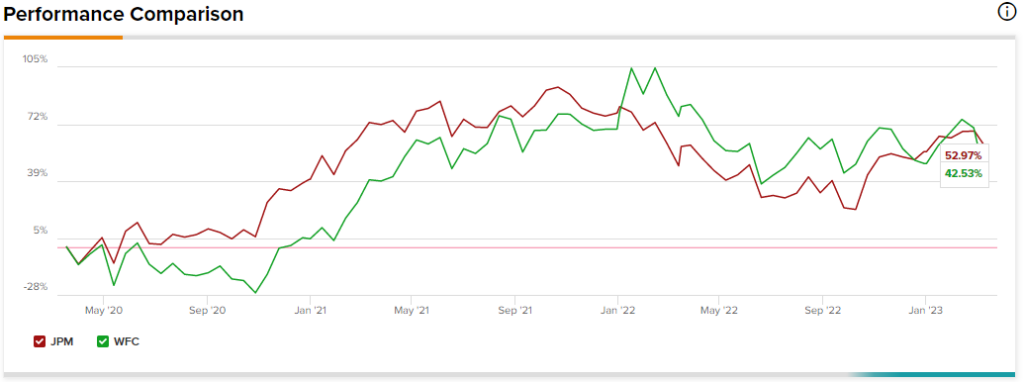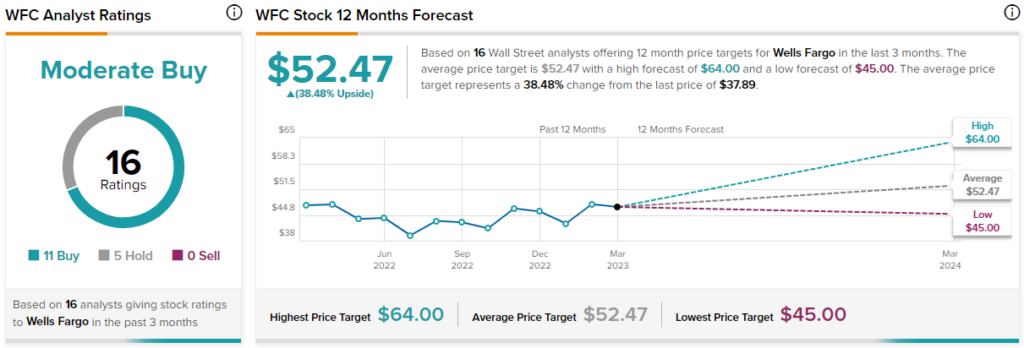In this piece, I used TipRanks’ comparison tool to evaluate two big bank stocks, JPMorgan Chase (NYSE:JPM) and Wells Fargo (NYSE:WFC), to determine which is better. Although both firms are stalwart and considered “too big to fail,” meaning regulators probably won’t allow them to go under, the collapses of Silicon Valley Bank and Signature Bank did have small impacts.
JPMorgan stock is down 5.5% for the last five days, while Wells Fargo is down more than 8%. Thus, it makes sense to consider whether these sell-offs are sufficient enough to trigger a buy-the-dip opportunity.
JPMorgan Chase shares are down 10% for the last 12 months, so they’ve held up better than Wells Fargo stock, which is off 26% over the same timeframe. Nonetheless, both stocks are good, but a closer look suggests that WFC is the better stock. Let’s examine why.

JPMorgan Chase (NYSE:JPM)
While both firms are massive, JPMorgan Chase is significantly larger than Wells Fargo, raking in $128.6 billion in revenue for 2022 versus the latter’s $73.8 billion. However, a closer look at JPMorgan’s valuation multiples following the recent sell-off suggests a bullish view may be appropriate.
The firm is trading at a price-to-earnings (P/E) ratio of about 10.4x, which is significantly below the financials sector’s P/E ratio of 16.4x and its three-year average of 14x.
JPMorgan’s current P/E is also on the low side relative to its history, as its mean P/E since May 2018 is 12.2x. Turning to its price/book multiple, JPMorgan is currently at around 1.4x. Anything over 1.0 for a book value per share suggests a stock is overvalued, but a review of JPMorgan’s history shows that the firm always trades at a slight premium on book value.
At 1.4x, the firm’s book ratio is also fairly low relative to its history, as its mean since May 2018 stands at around 1.6x. Also, JPM’s price-to-sales (P/S) ratio of 3.1x is a bit higher than the industry median but is slightly below its historical average of 3.5x.
Finally, JPMorgan also offers a dividend yield of 3.1%, making it a solid dividend play.
What is the Price Target for JPM Stock?
JPMorgan Chase has a Moderate Buy consensus rating based on 11 Buys, four Holds, and zero Sell ratings assigned over the last three months. At $156.87, the average JPMorgan Chase stock price target implies upside potential of 24.4%.

Wells Fargo (NYSE:WFC)
Wells Fargo has sold off a lot more than JPMorgan, but a review of the two firms’ fundamentals doesn’t really show why. Wells Fargo’s valuation multiples suggest a bullish view may be appropriate in the near term, especially since it appears as if the firm may offer the potential for more upside than JPMorgan at current levels.
First, Wells Fargo is trading at a P/E of about 12.4 times, putting it below the financials sector. Also, looking at Wells Fargo’s P/E since 2018 reveals a mean of 20.7 times, so its current P/E is low relative to its history. And although the firm’s P/E is higher than JPMorgan’s, its price-to-book ratio of 0.9x suggests it’s trading at a discount. Additionally, Wells Fargo’s mean price-to-book ratio stands at around 1.1, so there’s room for upside there.
Additionally, the firm’s P/S ratio stands at around 2.0 versus its mean P/S of 2.4 since May 2018. Finally, Wells Fargo also offers a dividend yield of 3%, making it a solid dividend pick.
What is the Price Target for WFC Stock?
According to analysts, Wells Fargo has a Moderate Buy consensus rating based on 11 Buys, five Holds, and zero Sell ratings assigned over the last three months. At $52.47, the average Wells Fargo stock price target implies upside potential of 38.5%.

Conclusion: Bullish on JPM and WFC, but WFC Looks Better
The recent sell-off in the banking sector has made some firms look attractive from a valuation standpoint. Of course, a long-term view is also advised, and it’s hard to go wrong with either JPMorgan Chase or Wells Fargo.
With both firms classified as “too big to fail,” the question of which is better is less about the state of their near- or long-term financial prospects and more about which may offer more upside than the other.
Ultimately, while both may be solid additions to a dividend portfolio or even to a long-term fundamental portfolio, the steeper sell-off in Wells Fargo shares suggests the firm could offer more upside in the near term than JPMorgan.

